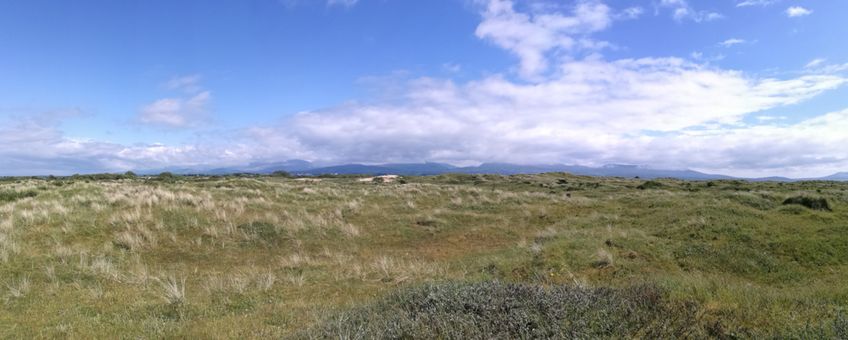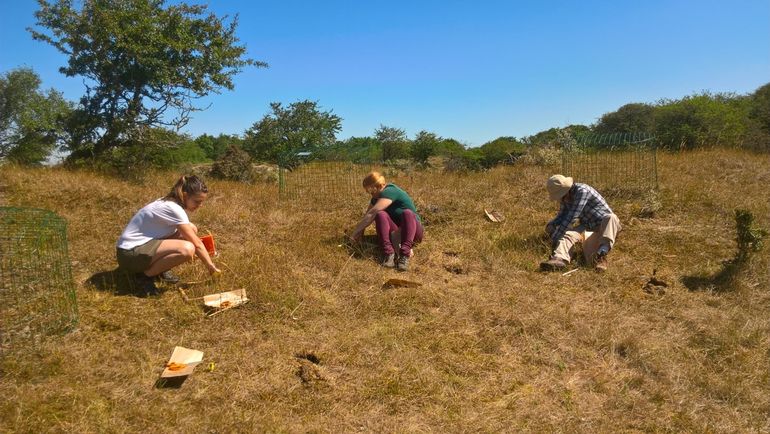
Sand deposition helps dune grasslands as a mitigating measure for a high nitrogen deposition
KWR Water Research InstituteIn 2018 and 2019 research was conducted into the effects of sand drift in dune grasslands as a nitrogen-mitigation measure, commissioned by the Dutch water utilities who manage nature that is sensitive to nitrogen. The research was carried out by KWR Water Research Institute, University of Amsterdam and Center for Ecology and Hydrology.
Blowouts can be initiated by topsoil removal or excavating soil to promote small-scale sand deposition of calcareous sand in old dune grasslands. In many Dutch dune areas such measures will be carried out in near future. In order to assess the mitigating effects existing sites near active blowouts were compared with sites which had no sand deposition during the last decades. Observations were made on the effects on the decomposition rate of organic matter, nitrogen balance (stocks, nitrogen release through organic matter decomposition, leaching to the groundwater), productivity and species composition of the vegetation. Since the restoration impact of a measure can be limited under conditions of continuously high nitrogen input, a comparison was also made between an area with a high level of nitrogen deposition and one with a low level.
Sand drift in dune grasslands
 The effects of sand deposition were studied in the Amsterdamse Waterleidingduinen, a dune system that is used as a water-collection area in the Netherlands (high nitrogen deposition), and in Newborough Warren in Wales (low nitrogen deposition). Old dune grasslands with sand deposition in both areas were compared with control sites that had not experienced any sand drift for a long period of time.
The effects of sand deposition were studied in the Amsterdamse Waterleidingduinen, a dune system that is used as a water-collection area in the Netherlands (high nitrogen deposition), and in Newborough Warren in Wales (low nitrogen deposition). Old dune grasslands with sand deposition in both areas were compared with control sites that had not experienced any sand drift for a long period of time.
The results show that weak sand deposition has no influence on the amount of nitrogen released through organic matter decomposition. In the Dutch dune area, under conditions of light sand deposition, the topsoil was clearly less acidic than that in the control sites. The sand deposition also led to a greater coverage of base-loving mosses and a lower coverage of acid-loving mosses. The outcomes show that the positive effect of the measure in the Netherlands works through the increase of the pH of the topsoil that was strongly acidified. A higher pH implies the soil is less acidic and is richer in calcium.

Effects of high and low nitrogen deposition
It is striking that the decomposition of organic matter in the soil in Wales (low nitrogen deposition) occurs more rapidly than in the Netherlands (high nitrogen deposition), while just as much nitrogen is released from the soil in both areas. Thus, in the Netherlands, with the same amount of decomposed organic matter, more nitrogen is released. This pattern might have to do with the differences in soil acidity, availability of phosphorus and possibly the composition and functioning of the microbial community (the bacteria and fungi).
Mosses in the Netherlands also have a higher nitrogen content and often a higher biomass than those in Wales. This means they play a bigger role in the nitrogen cycle. The Dutch dune grasslands have variable levels of nitrogen leaching to the groundwater. On average, this is higher than it is in Wales. This indicates that in the Dutch area dune grasslands still have an excess of nitrogen. In the Netherlands the proportion of grasses is higher and that of herbs lower; in Wales the herbs are more significant. This is possibly a result of differences in the amount of nitrogen which is deposited.

Implications for management and policy
Dutch nature policy is strongly focused on tackling the nitrogen problem through the large-scale implementation of measures in Natura 2000 areas which should alleviate the adverse effects of a high nitrogen deposition (mitigating measures). The measures were set in motion and the deposition levels should gradually drop, however, over the last few years this trend has stagnated. The research shows that the promotion of sand deposition helps restore the vegetation in dune grasslands. However, although the measure does in fact work for the ecological restoration, it has no positive effect on the nitrogen balance. The high nitrogen deposition continues to have an impact on the vegetation. The situation with regard to the many other mitigation measures that are presumed to have a favourable impact on the ecosystem nitrogen balance has barely been investigated. It would therefore be desirable to increase our understanding in this regard. The implementation of measures in nature areas makes sense for purposes of ecological restoration, but the negative impact of a high nitrogen deposition must be addressed principally by cutting nitrogen pollution.
More information
- Report Effectiveness of measures to mitigate high nitrogen deposition in dry habitats
- Leaflet Small scale wind erosion for the benefit of coastal dune grasslands (pdf 3.5 MB)
Text: Camiel Aggenbach, KWR Water Research Institute; Luc Geelen, Waternet
Photos: Luc Geelen
Figures: Camiel Aggenbach
